Learning to value emerging markets and higher risk stocks The Globe and Mail
Post on: 1 Май, 2015 No Comment

Not so fast. My research shows that, while forward P/E ratios are a good indicator of future returns for NYSE stocks, they are poor predictors of future returns for AMEX and Nasdaq stocks, namely the riskier groups of stocks that also include emerging market ETFs.
In my research, I sorted all stocks in each of the AMEX, Nasdaq and NYSE markets into quartiles using forward P/E ratios and examined each quartile’s stock returns in the year following the sorting. I followed this procedure in every year for the period from 1986 to 2006.
I ended up with a time series of annual returns between 1986 and 2006. I then examined whether sorting by forward P/Es the year before could predict stock returns in the following year. Particularly, I examined the following question: Do low forward P/E quartile stocks yield, on average, a higher return than the high P/E quartile stocks?
Overall, the low P/E quartile had the same return as the high P/E quartile for AMEX stocks, and beat the high P/E quartile by 2.4 per cent for Nasdaq and by 11.6 per cent for NYSE stocks. That is, it was only for NYSE stocks that focusing on low forward P/E ratios made a real difference in future returns.
Now compare these findings with the case when the same procedure was followed using trailing P/E ratios. Overall, the low P/E quartile beat the high P/E quartile by 6.2 per cent for AMEX stocks, 11.4 per cent for Nasdaq stocks and 6 per cent for NYSE stocks. By any measure, these results are economically and statistically significant. Choosing low trailing P/E stocks would make a large difference in future returns in all markets examined.
But why is it that trailing P/E ratios have a better predictive power than forward P/E ratios?
This has to do with the fact that analysts tend to be overoptimistic when forecasting earnings. This biases the forward P/E ratio and makes it an inaccurate predictor of future stock returns (particularly in the riskier markets) in comparison with the trailing P/E ratio, which is based on realized earnings.
In research I carried out looking at the accuracy of U.S. analysts’ forecasts, I found that, on average within a calendar year, analysts overestimate actual earnings by about 2.5 per cent.
But the overestimation is about 8 per cent at the start of the forecasting period, which is some time around June of the year before the forecasted year. Accuracy improves as analysts approach the end of the year that they are forecasting.
What is more interesting, however, is that analysts are not overoptimistic across all companies covered. They tend to be overoptimistic only for stocks for which there is high uncertainty about the future. For stocks with low uncertainty, analysts tend to be pretty accurate.
Sorting stocks into quartiles by the standard deviation of analysts’ forecasts (a measure of analyst uncertainty about the future of a firm), I found that for low uncertainty stocks analysts exhibit no forecast error on average within a calendar year.
But when it comes to the highest uncertainty group of stocks, analysts tend to overestimate actual earnings by 21 per cent on average. At the beginning of the forecast period the overestimation is 34.3 per cent. These are big errors, hence the inaccuracy of forward P/E ratios.
In other words, forward P/E ratios can be a good predictor of future returns for low uncertainty stocks but are quite inaccurate for high uncertainty stocks. That explains why forward P/E ratios, while working well in predicting future returns for NYSE stocks, do not work as well for AMEX and NASDAQ stocks in comparison with the trailing P/E ratios.
As a result, if investors wish to avoid worrying about the uncertainty underlying a company’s future, they should consistently use trailing ratios across the board as a more effective metric to screen stocks and predict future stock returns.
In fact, it is trailing ratios that value investors tend to emphasize and this is the ratio that Benjamin Graham, the father of value investing, focused on when he wanted to screen stocks for possible undervaluation. Investors should do the same, especially when it comes to emerging markets.














